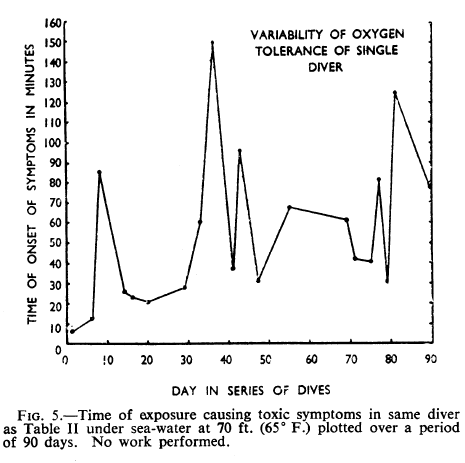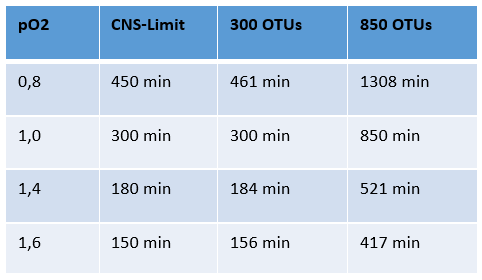One of the most important things you learn in every Nitrox course is that you can get an oxygen toxicity hit at high oxygen partial pressures. This can lead to seizures, which are difficult to survive under water.
That’s true, without a doubt, and we definitely don’t want to take that risk. But what actually has to happen to get really close to the limits? And what side effects does the fear of oxygen toxicity have on divers?
When do the seizures start?
The most feared of the “OxTox hits” is the CNS Toxicity. Excessively high pO2 leads to central nervous system problems such as impaired vision and hearing, dizziness, a metallic taste in the mouth, sensory disturbances – and ultimately to convulsions.
A seizure under water is a very serious matter: breathing can no longer be controlled, the whole body twitches or stops moving altogether – such a condition is more than just unpleasant on land, under water it is likely to be fatal.
That is why we want to avoid this symptoms under water at all costs. We therefore stay far enough away from all recommended limits – preferably as far as all our diving associations recommend: For normal dives with Nitrox, 1.4 bar pO2 is considered safe; for prolonged exposure such as with a rebreather, 1.3 bar or less is more likely to keep you below this limit.
In dry conditions, e.g. with pressure chamber treatments, the values look completely different. Breathing pure oxygen at 18m? No problem, this is done regularly. The seizures that sometimes occur are accepted for the success of the treatment. But you are sitting on dry land, where the probability is much lower than when you are moving under water – and the result is not dramatic.
But you can already guess from this: Unfortunately, the limit values are not empirically substantiated by any stretch of the imagination, and the “CNS clock” is repeatedly criticized. Because the mechanisms of how oxygen toxicity leads to symptoms are not fully understood, and because these reactions occur so chaotically and unpredictably, determining limits is more guesswork than science.
Nevertheless, these limits have proven their worth over the years. Within these limits, you can be nearly absolutely certain that you will not experience oxygen poisoning. The NOAA limits, also known as the “CNS clock”, have now been used successfully for decades and appear to have made oxygen toxicity accidents extremely rare.
So you can feel safe within the limits, but the reverse is not true: if you exceed them, you will not be struck by lightning or oxygen toxicity immediately. It’s just that the risk is increasing and we don’t normally want to accept that. It’s a bit like the M values – you have to draw a line somewhere, but it’s not a hard limit, it’s set somewhere in a vague area of increasing risk.
The big problem with CNS poisoning is that it is unpredictable. In most cases, the symptoms appear very quickly under water – or we don’t know exactly whether anything was felt beforehand because the victim can no longer report.
It is known from pressure chamber experiments which symptoms occur before the cramps. Experiments published in 1947, in which people were exposed to oxygen in a pressurized chamber at over 3 bar for so long that the first symptoms became noticeable, are still used today. This also resulted in a few seizures, so the experiments were somewhat dangerous. That is why we are still using these very old results today: There is no reason to repeat experiments in which people are harmed, and certainly not when new results are not even expected.
From this source comes a graph of CNS toxicity that shows very clearly how chaotic its occurrence is. What becomes clear here: In one and the same person, symptoms of oxygen toxicity can occur after extremely different lengths of time. It is neither trainable nor in any way predictable how long it will take on any given day.
What does that mean for us? Because it is unclear exactly when the symptoms will start, a very large safety distance from the area in which this can happen is appropriate. On the other hand, you can also see that the symptoms do not start with the first few breaths. This is also logical to a certain extent: the oxygen first has to get into the body and start doing unwanted things, and that takes a few minutes.
For further reading: DONALD: Oxygen poisoning in man. 1947

Are OTUs a thing?
First of all: No.
Not for us at least, if we do a few dives a day within the no-decompression limits with Nitrox. This can be different for treatments in the pressure chamber and also for very long rebreather dives.
OTUs, Oxygen Toxicity Units, are a unit that can be used to determine how long someone can breathe oxygen at a higher pressure than normal without damaging the lungs. There is a fairly solid database on this, and if you want to continue to have functioning lungs, it is wise to stick to the recommended maximum values. At 300 OTUs a day for several days in a row, or even 850 a day for individual days, they are always very high.
For recreational diving, we therefore have another limit: the CNS clock. If we stick to them, we won’t care about the OTUs – as you can clearly see here in the table.

At what point does the pO2 become a problem? So, all in all?
One could now come up with the idea that our limit values are very conservative. If people don’t feel any symptoms for a long time even with a pO2 of 3 bar, why then our narrow limits?
Quite simply, the limits used to be somewhat wider, at 1.6 or even 1.8 bar pO2. Over time, however, it has become apparent that oxygen intoxication does occur in this range from time to time, especially when other things such as exertion are added to the high pO2. And you can’t rule out having to make an effort when diving.
Accidents in which oxygen poisoning plays a role are now very rare – and the few that do occur are surprisingly easy to explain. There was the rebreather diver who simply raised his pO2 to 2 bar – which worked well for a very long time, long enough to feel safe and always do it that way, because there was much less deco…. Until it just didn’t go well any more. Because it is not possible to predict exactly after how much time it will happen, but at such a pO2 it will happen at some point. And then there are always mix-ups during technical diving: If you accidentally switch to pure oxygen instead of EAN50 at 21m, things can go wrong. Incidentally, you can also be lucky and nothing happens. But under no circumstances should you start convulsing with the first few breaths – perhaps the confirming look at the buddy’s gas after the gas change is much more important than watching the action. But that’s just a side note…
Accidents involving oxygen poisoning in normal recreational diving with nitrox, where all limits have not been exceeded grossly and over a long period of time, no longer occur. As long as you know what exactly is in the bottle and stick to the 1.4 bar pO2, you really don’t need to worry. Not at all.
OxTox panic: The biggest risk?
Nevertheless, the fear of oxygen toxicity is great and widespread. How many of you have heard it before – that guide who proudly tells you that he won’t go any deeper than so-and-so because he has Nitrox and would surely be poisoned?
Who has ever been asked whether it would be better to take two days off because MOD flashed on the computer?
Apart from the absolutely irresponsible behavior of a guide, it is simply not conducive to a relaxed dive if you are constantly afraid. Fear can turn into panic at the slightest problem – and this is REALLY dangerous underwater. So what should we really be afraid of, and what should we not be afraid of?
We have seen that you rarely get problems below a pO2 of 2 bar. Rare is not enough for us, because you can usually survive the problems on land – but not under water. To go from rarely to never, it makes sense to set the limit at 1.4 bar pO2.
This means that even at a pO2 of 2 bar, it is unlikely that someone will convulse in the next moment. But yes: it can happen from then on.
Our limit values are chosen so that we still have a few meters of leeway. But they are there for exactly one thing: Emergencies. They are NOT part of our dive planning.
I plan my dives with a pO2 of 1.4 bar at the deepest point OC, 1.3 bar pO2 CC (where you are exposed to this pO2 for longer). For deco, at moderate to shallow depths, I then go to 1.6 bar pO2 – for a limited time.
But the panic thing – it’s really important to know that the limits are not rigid. You do not suffer poisoning at a certain dose inmediately and automatically. So if there is an important reason to cross the border for a short time, you can do so. Of course you can help your buddy if you have to accept a pO2 of 1.7 for 2-3 minutes until you ascend together.
It’s difficult to say exactly where to set the limit – but if we plan for 1.4 bar pO2, we always have a margin.
Experiencing a very high pO2 for a short time is almost always good. Only a longer exposure time causes problems. If you had a pO2 that was too high, you should reduce it afterwards, i.e. increase it a little (or change the setpoint on the CCR)
But the most important thing is: DON’T PANIC!
